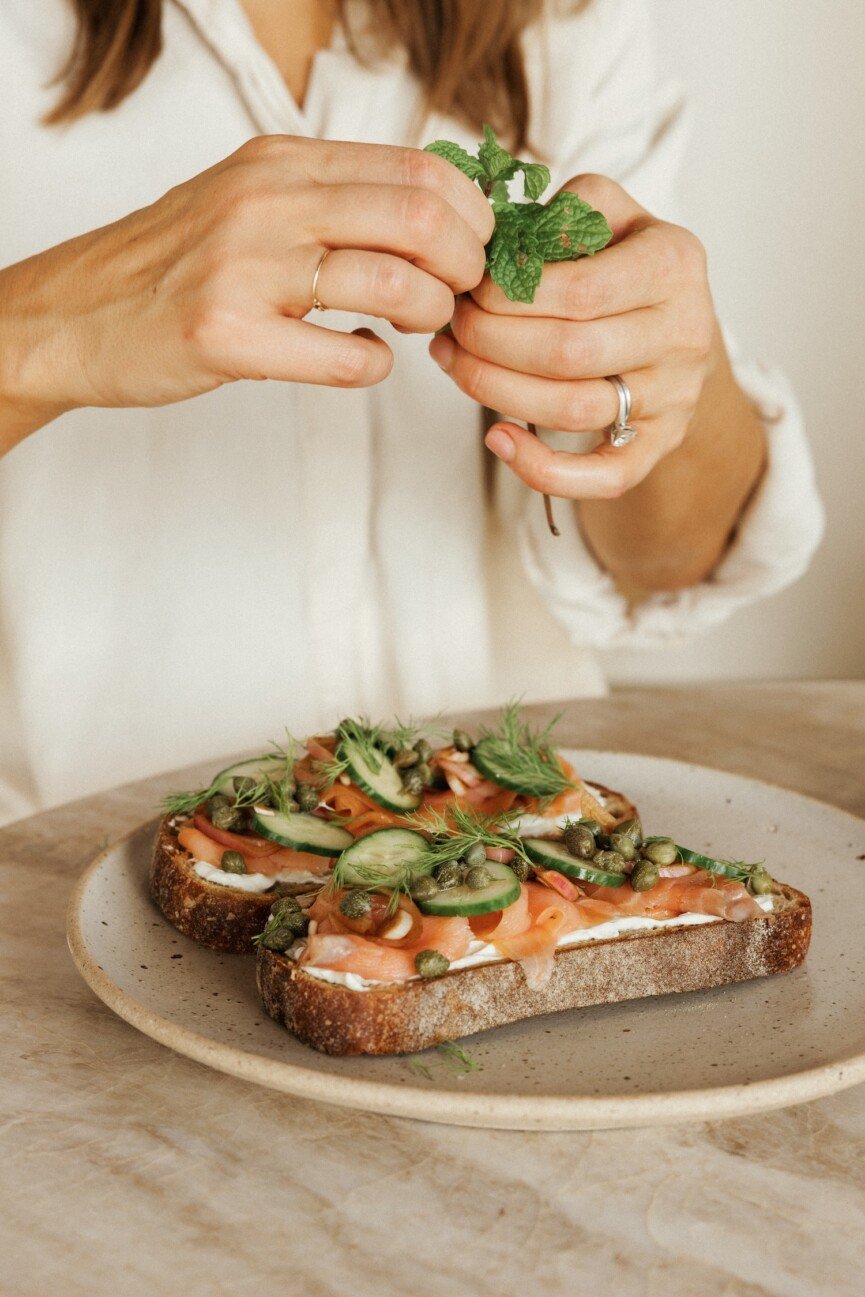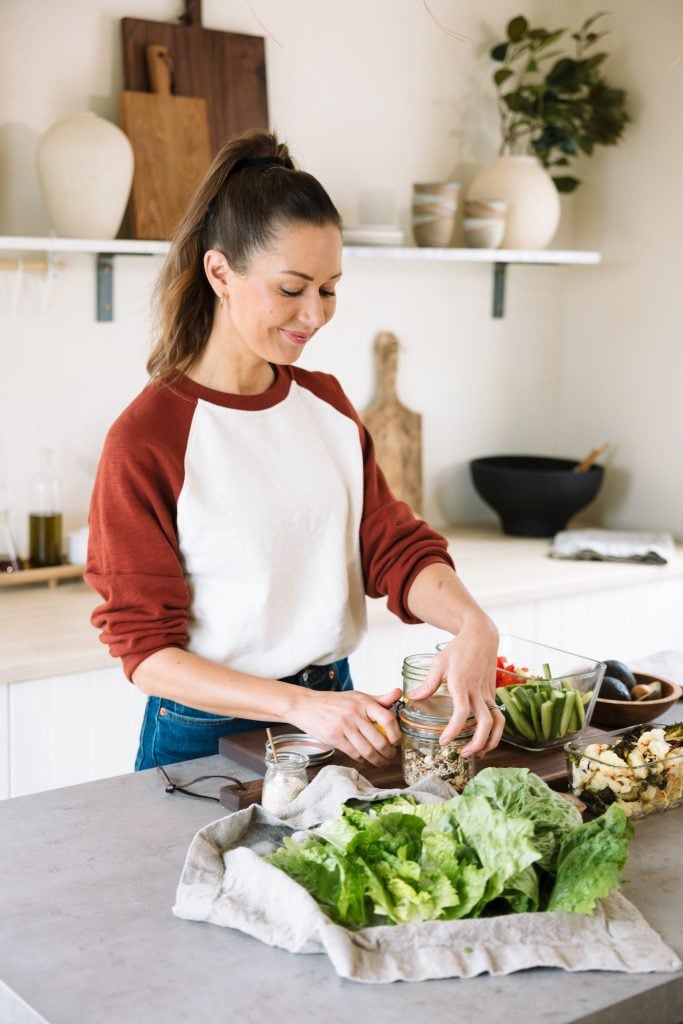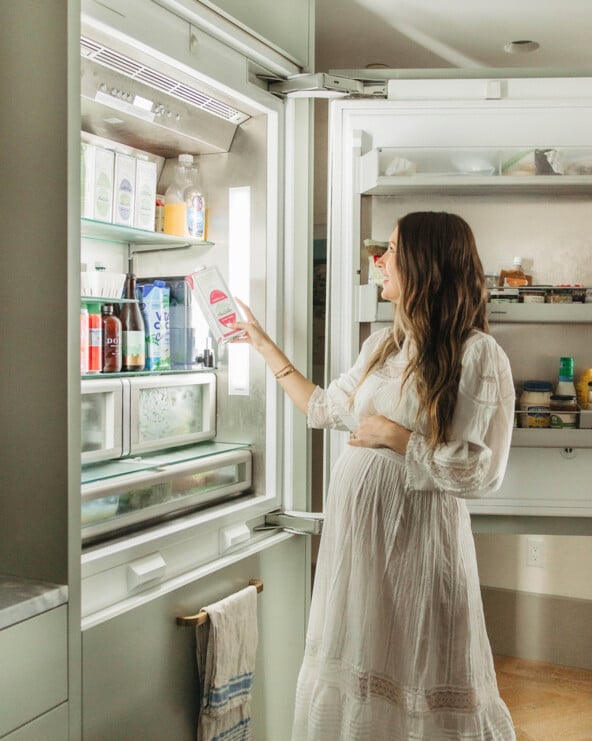You have deadlines, dishes, and a dozen texts to respond to. Figuring out what to eat shouldn’t be another source of decision fatigue. But if there’s one thing I’ve learned as a nutrition consultant and mom, it’s this: The right kind of fuel (namely, getting enough protein!) can make everything else feel more doable. The secret? Simplicity. We’re talking a full week of breakfast, lunch, and dinner ideas you can prep or pull together in no time.
Best of all, these meals are as balanced as they are satisfying. Think: 20+ grams of protein per meal (yes, even breakfast), zero crash, and no complicated ingredients. Let’s dive into the easiest high-protein meal plan for busy women—plus, a free printable version—to hang on your fridge or screenshot for the week ahead.
Feature image by Michelle Nash.


Why focus on protein?
Before we dive into the recipes, here’s your reminder: Protein is foundational for women’s health—no matter your circumstances. In other words, it’s not just for gym-goers or bodybuilders. Protein supports everything from blood sugar regulation to muscle preservation (so important as we age!) and hormone synthesis. It’s also crucial if you’re pregnant or postpartum. And if you’re trying to cut back on sugar, protein is your secret weapon. Studies show that protein-rich meals can reduce cravings. Despite its importance, many women aren’t getting enough. According to dietary surveys, most adult women fall short on the amount of protein needed at breakfast. The result? Mid-morning crashes, cravings, and low energy.
How much protein do women really need?
If you’re wondering how much protein you actually need, you’re not alone. Experts—like Dr. Gabrielle Lyon—and organizations, like Levels Health, advocate for a higher amount than the standard RDA. Lyon recommends women aim for at least 1.2–1.6 grams of protein per kilogram of body weight per day. Starting strong, with 30 grams or more at breakfast, can do the trick to trigger muscle protein synthesis. And this is important whether you’re trying to build muscle or lose body fat.
Your Ideal Protein Intake, Based on Weight
To help you estimate your daily needs, use the chart below to find your ideal protein range based on body weight. Generally speaking, most women should aim for at least 100 grams of protein per day to support energy, hormones, and lean muscle.
| Body Weight (lbs) | Minimum Daily Protein (g) | Optimal Daily Protein (g) |
|---|---|---|
| 120 lbs | 78g | 90g |
| 130 lbs | 85g | 98g |
| 140 lbs | 91g | 105g |
| 150 lbs | 98g | 113g |
| 160 lbs | 104g | 120g |
| 170 lbs | 111g | 128g |
| 180 lbs | 117g | 135g |
| 190 lbs | 124g | 143g |
| 200 lbs | 130g | 150g |
Of course, take this with a grain of salt—your needs may vary based on activity level, life stage, or specific health goals. But if you’re not sure how much protein you’re currently getting, try tracking your intake for a week to get a clearer picture—it can be eye-opening.
The Science-Backed Benefits of a High-Protein Diet
Here’s what a protein-forward day can do for you:
1. Keep You Fuller, Longer
Pairing protein with fiber is a powerful tool for satiety. It helps you feel fuller between meals and less likely to snack on ultra-processed foods. Win-win.
2. Minimize Sugar Cravings and Energy Crashes
As mentioned, meals higher in protein (especially earlier in the day) are linked with better glucose control, fewer cravings, and longer-lasting energy. Think of protein as your blood sugar bodyguard. It slows the digestion of carbs, which means you avoid the need for an afternoon cold brew.
3. Support Hormonal Balance
Protein isn’t just about muscle—it also plays a critical role in hormone production and regulation. From thyroid hormones to reproductive hormones like estrogen and progesterone, your body needs amino acids (from protein!) to function properly.
4. Build Stronger, Healthier Cells
Every cell in your body—skin, hair, nails, organs, and more—requires protein to grow and repair. Amino acids are the building blocks for new tissue, helping your body regenerate and heal on a cellular level. Prioritizing protein means supporting your body from the inside out, whether you’re recovering from a tough workout or simply navigating a busy season of life.
But the solution doesn’t have to be complicated. Small shifts, like adding a scoop of protein powder to your smoothie or adding egg whites to your omelet, can make a big difference. Think of protein as your daily anchor, no matter how full your plate is.
A Full Week of High-Protein Meals
Think of this as your plug-and-play guide to eating well without overthinking it. Each meal is designed to provide between 25–40 grams of protein, along with balanced carbs and healthy fats to keep your energy levels high and metabolism humming. Feel free to repeat favorite meals, mix-and-match components, or double up on recipes to simplify your week (especially for busy days when cooking isn’t realistic). Whether you prep ingredients ahead of time or cook in real-time, this template is flexible, nourishing, and totally doable.
Monday
Breakfast: Greek yogurt parfait
- ¾ cup plain Greek yogurt (~17g protein)
- 1 scoop vanilla protein powder (~15g protein)
- 2 tbsp hemp seeds (~3g protein)
- Handful of berries
Lunch: Turkey roll-ups
- 4 oz turkey breast (~28g protein)
- 2 hard-boiled eggs (~12g protein)
- 1 tbsp hummus, spinach, and provolone slices (2-3g protein)
- Crackers (like Mary’s Gone) on the side
Dinner: Salmon and veggies
- 5 oz baked salmon (~30g protein)
- Roasted sweet potatoes and broccoli
- 1 tbsp tahini (~3g protein)
Tuesday
Breakfast: Scrambled eggs and toast
- 2 large eggs (~12g protein)
- ¼ cup cottage cheese (~7g protein)
- 1 slice sprouted grain toast (~4g protein)
- 1 tbsp almond butter (~3g protein)
- Sautéed spinach and mushrooms (~2g protein)
Lunch: Quinoa salad
- 4 oz cooked chicken breast (~28g protein)
- ½ cup cooked quinoa (~4g protein)
- ¼ cup feta cheese (~3g protein)
- Cucumbers, tomatoes, olive oil
Dinner: Steak and greens
- 5 oz grass-fed beef steak salad (~35g protein)
Wednesday
Breakfast: Oatmeal (hot or overnight oats!)
- ½ cup rolled oats (~5g protein)
- 1 tbsp chia seeds (~2g protein)
- 1 tbsp peanut butter (~4g protein)
- 1 scoop protein powder (~15g protein)
- Made with flax milk (~1g protein)
Lunch: Tuna and tomato toast
- Tuna and avocado toast with roasted tomatoes (~30g protein)
- Side of carrots
Dinner: Chicken and veggie bowl
- 6 oz baked chicken thighs (~35g protein)
- Roasted carrots and ½ cup cooked lentils (~9g protein)
Thursday
Breakfast: Strawberries and cottage cheese
- 1 cup cottage cheese (~28g protein)
- Large handful strawberries
- 1 tbsp flaxseed (~2g protein)
- ¼ cup walnuts (~5g protein)
- Cinnamon
Lunch: Mexican-inspired bowl
- 4 oz leftover cooked chicken (~28g protein)
- ½ cup cooked black beans (~7g protein)
- ½ cup cooked brown rice (~3g protein)
- ½ avocado
- Handful cilantro
- Squeeze of lime
Dinner: Meatballs with zoodles
- Turkey meatballs made with 5 oz lean ground turkey (~35g protein)
- Marinara sauce and zucchini noodles
Friday
Breakfast: Protein pancakes
- Protein pancakes made with 1 scoop protein powder (~15g protein)
- ¼ cup Greek yogurt topping (~5g protein)
- Berries
Lunch: Salmon nicoise salad
- 5 oz salmon (~30g protein)
- 2 boiled eggs (~12g protein)
- Greens, potatoes, green beans
Dinner: Shrimp tacos
- 5 oz shrimp (~30g protein)
- Almond flour tortillas
Saturday
Breakfast: Strawberry probiotic smoothie
- Smoothie with 1 scoop protein powder (~25g protein)
Lunch: Chicken and veggie plate
- 4 oz chicken sausage (~28g protein)
- Sautéed kale, sweet potato, onions
- Crumbled feta (~6g protein)
Dinner: Burgers
- 6 oz bun-less beef burger (~40g protein) or falafel burgers (less protein, so consider adding a simple vanilla protein smoothie on the side!)
- Mushrooms, pickles, side salad
Sunday
Breakfast: Frittata
- Veggie-packed frittata with 3 eggs (~18g protein)
- 1 oz goat cheese (~6g protein)
- 1 slice sourdough (~4g protein)
Lunch: Protein snack plate
- 3 oz turkey (~21g protein)
- 1 oz sharp cheddar cheese (~7g protein)
- Handful cherries
- Handful baby carrots
- 2 tbsp hummus
Dinner: Banh mí bowls
- Tofu (~20g protein)
- Veggies
- Rice
How to Make This High-Protein Meal Plan Work
No need for rigid tracking or macro counting. Here’s how to make this feel effortless:
1. Choose Your Protein First
When planning a meal, ask: What’s my protein source? Build around that. Whether it’s eggs, tofu, beans, or grass-fed meat, starting with protein sets the tone.
2. Pair with Fiber
Most summer breakfasts lean sweet—think granola, toast, smoothies. These aren’t “bad,” but they often lack fiber, which is crucial for digestion, hormone health, and blood sugar control. Add ground flax, chia, hemp seeds, or veggies to round it out.
3. Lean Into Repeats
There’s no gold medal for meal variety. Love the tuna and avocado toast? Have it twice this week. When you’re busy, repeats = less stress.
4. Prep the Basics
Even just prepping a few things—like a batch of quinoa, chopped veggies, or hard-boiled eggs—makes sticking to your high-protein meal plan so much easier.









